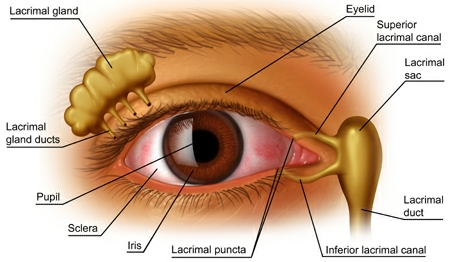Dry Eye Syndrome, also known as keratoconjunctivitis sicca is a chronic condition in which a person doesn’t have enough quality tears to lubricate and nourish the eye. Tears are necessary for maintaining the health of the front surface of the eye and for providing clear vision. Dry eye is a common (more than 3 million cases in the US per year) and often chronic problem particularly in older adults.
Dry eye is:
- Treatable by a medical professional
- Lab tests or imaging is rarely required
- Medium – term: resolved within months
- Risk of acquiring this condition increases with age
- The eye may become dry, red, and inflamed, the main symptoms are discomfort
Scientists believe that inflammation on the surface of the eye may be a key factor in causing dry eye. Inflammation is typically, an immune system response to stress, irritation, bacteria or toxins, some triggers include:
- Prolonged screen time
- Reading a lot
- Certain medications can reduce tear production
- Some medical conditions
- Long – term use of contact lenses
- Refractive eye surgeries
- Some diseases
Dry eye disease has a variety of causes, but also has several approaches to treat dry eye. The following are treatments or combination of treatments commonly used:
- Artificial Tears-eye drops used to lubricate the eye
- Restasis-eye drops containing cyclosporine, an immunosuppressant can increase tear production by reducing inflammation.
- Xiidra-works by blocking a certain protein on the surface of cells in your body.
- Steroid eye drops-contain corticosteroids to treat inflammation and relieve swelling, pain, redness or irritation.
- Lacrisert-a sterile, translucent, rod-shaped, water soluble lubricant that is inserted into the eye to provide up to 24 hour relief from moderate to severe dry eye.
- Punctal plugs-tiny biocompatible devices that can be inserted into the tear ducts to block drainage.
- Meibomian gland expression-Tiny oil glands along the edge of the eyelids where the eyelashes are, they produce the oily substance that prevents evaporation of the eye tear film. These glands sometimes become clogged. The doctor will apply heat and gentle pressure to help loosen the clog in the gland.
- Warm Compresses- An alternative way to help open clogged Meibomian glands to treat dry eyes is to simply apply warm compresses to the closed eyelids to soften the hardened meibum.
- LipiFlow- the LipiFlow Thermal Pulsation System is an automated, in-office dry eye treatment that combines the best features of warm compress therapy and meibomian gland expression.
- Intense Pulsed Light- in IPL treatment, a hand-held device flashes bright light onto the skin. The light is filtered to allow only wavelengths that can be absorbed by the dilated blood vessels. The effect of this treatment may be the resolution of the dilated vessels and associated inflammation that contributes to dry eye symptoms.
- Nutritional Supplements- Studies have found that supplements containing omega-3 fatty acids can decrease dry eye symptoms. Good sources of omega-3s include cold-water fish such as salmon, sardines, herring and cod. For a vegetarian source of omega-3s, some eye doctors recommend flaxseed oil to relieve dry eye.
- Home Remedies for dry eye- Blink more frequently, Wear wraparound sunglasses to protect eyes from wind, dust and other irritants that can cause or worsen dry eye symptoms, Take frequent breaks during computer use, thoroughly remove eye makeup, clean your eyelids
- Medication Adjustments- Many medicines — including antihistamines, antidepressants, birth control pills, certain blood pressure medications and more — can cause or worsen dry eye symptoms.
- Discontinue or reduce Contact Lens wear- If you wear contact lenses, it can be difficult to tell if an underlying dry eye condition is causing contact lens discomfort or if your contact lenses are causing dry eye symptoms.
If you are having some of these symptoms please call for an appointment with Dr. Wendel 412.331.9696
#eyegotcha
#dryeye
Sources:

